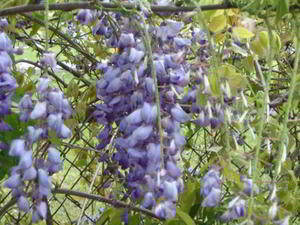Wisteria: either you love it or hate it, passionately. How could a flower so beautiful, which smells so wonderful, be compared to kudzu? Wisteria grows tremendously fast and it is so aggressive, it has been known to rupture water pipes under houses, lift siding off houses, bend chain link fences and crack concrete foundations. Is kudzu that bad?
Still, a flowering wisteria, whether tree or vine, is something to behold. If you must have one in your yard, planning for the addition of this fragrant display is the best way to avoid disappointment.
What you can do with Wisteria:
Trellis – One of the best ways to display a Wisteria vine is to train it to run up a trellis or on arbors.
Shade – Fast growing is both a curse and a blessing. The woodiness of the vine makes a good shade even when there are no blooms.
Up a tree – Training a wisteria vine up a tree can be attractive but chances are good it will eventually smother the tree.
Fence – Wisteria running a long a fence is gorgeous and it increases privacy the of a chain link fence. Don’t put the vine where cattle can have it for a snack; it will make them ill. Wisteria is also disgusting to deer; it’s officially deer repellent!
Training the vine to become a tree – By far the best way to enjoy Wisteria is in tree or standard form; it’s trained to go upward instead of outward. In choosing a place to for the Wisteria tree to live, pick a spot at least fifteen feet from anything it can climb. Train the vine to run up a stake; trim it frequently to the desired shape. Eventually, over years, the base will form a tree-like trunk.
Making a zebra change it stripes doesn’t happen overnight. It takes a lot of time and dedication to change a determined vine into a tree.
Bonsai – The Wisteria can also be trained to be a bonsai wisteria. This is the only way to enjoy the vine in your home. The effort would be well rewarded. Two varieties to transform into bonsai are the W. floribunda (Japanese) or W.sinensis (Chinese). If you are not sure which kind of Wisteria you have, look at the direction the vines twines. Japanese and American varieties twine clockwise, while Chinese twines counter-clockwise.
Any of these options are great but they need to be pruned every two to four weeks. The key to living peacefully with wisteria is being consistent with pruning. If it’s let go for too long it will get away from you, fast; then it becomes a monster that you regret.
Some differences among American, Japanese and Chinese varieties
American Wisteria is less aggressive than the oriental but also not as pleasantly fragrant.
Japanese Wisteria (Wisteria floribunda) develop blooms that can reach up to twenty inches in length. The Chinese (Wisteria sinensis) vine is slightly shorter than that. The heavier the flower, the more gracefully and dramatically it drapes.
American Wisteria is much shorter and not as heavy. The flower cluster reaches up to six inches; much shorter than the Japanese variety. The reduced weight of the American variety is said to cause it not drape as gracefully as the oriental types.
The difference in the seedpods of the American and Oriental varieties is the texture. The Oriental will have fuzzy pods and the American will be smooth. Pick up these pods or pinch them off the vine to prevent the vine from sprouting elsewhere.
The Japanese can grow up to thirty feet tall with the Chinese variety reaching heights of seventy feet tall.
The blooming process is also different between varieties. Have you ever watched Wisteria blooms open? The Japanese blooms open from base to tip, slowly; very pleasing. The Chinese variety opens in its entirety, at once. I much prefer the slow opening blooms.
First blooming can take up to seven years. Pruning the vine can sometimes force it to bloom. If it is already blooming wait until after it blooms to prune.
If you buy a plant from a nursery, blooming will occur faster. Growing Wisteria from seed can delay blooming by ten to fifteen years!
When I see a Wisteria vine or tree, I never think of their nuisance, only their beauty.
